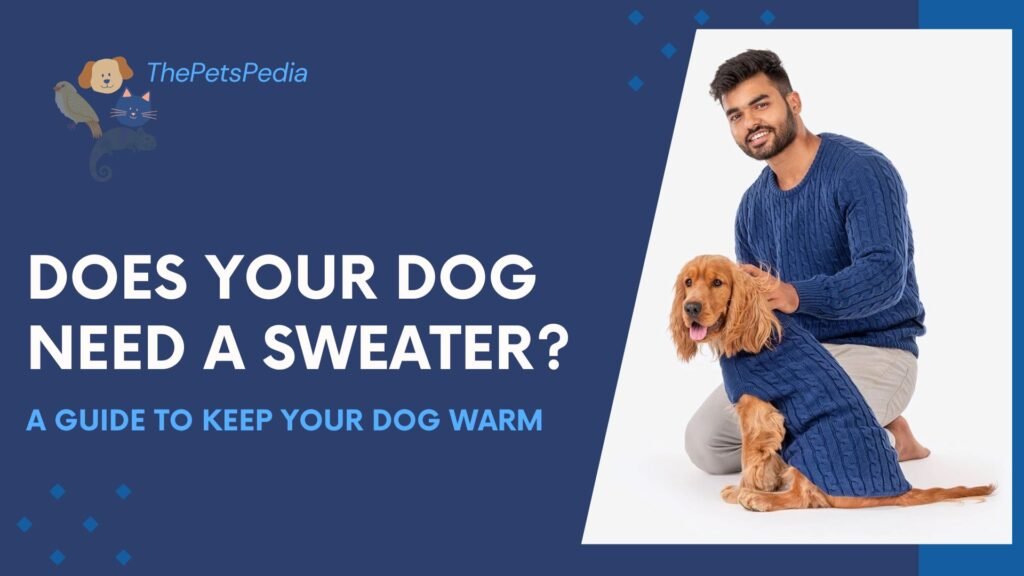As the weather cools, many dog owners wonder, does your dog need a sweater? While the idea of dressing up your dog may seem like a trend, it’s important to understand that in certain conditions, dog sweaters are not just fashionable accessories, but practical necessities. Depending on factors such as breed, age, size, health, and climate, dog sweaters can help ensure your furry friend stays comfortable and healthy during the colder months.
In this guide, we’ll address all the important aspects of dog sweaters, including why some dogs need them, how to choose the right one, and when it may be unnecessary to use one. Whether your dog enjoys wearing sweaters or needs extra warmth due to health conditions or environmental factors, we’ll cover everything you need to know to keep your dog comfortable all season long.
Why Do Some Dogs Need Sweaters?
Not all dogs need sweaters, but there are several reasons why dog sweaters might be necessary for certain dogs. These reasons depend on a variety of factors like breed, size, health, and age. Here’s a closer look at why your dog needs a sweater:
1. Small Breeds and Short-Haired Dogs
Small dog breeds with short coats, like Chihuahuas, Italian Greyhounds, and Miniature Pinschers, tend to get cold more easily due to their lack of body fat and shorter fur. These breeds, which are more prone to temperature fluctuations, benefit significantly from wearing a dog sweater. A sweater helps maintain their body temperature and provides extra insulation during colder weather.
2. Hairless Dog Breeds
Hairless dog breeds like the Chinese Crested or the Xoloitzcuintli are especially vulnerable to the cold, as they have little to no fur. Their skin is more exposed to the elements, which can result in discomfort, skin damage, or even hypothermia in extreme weather. For these dogs, does your dog need a sweater? Yes, a dog sweater is a must-have to help regulate body temperature and provide protection.
“In colder months, hairless breeds like the Chinese Crested need to wear a sweater to avoid cold stress and skin issues.” — Dr. Jennifer Phillips, Veterinary Dermatologist.
3. Senior Dogs
Older dogs are often less able to regulate their body temperature. As dogs age, they lose muscle mass and fat, which can make it harder for them to stay warm. Suppose your senior dog suffers from joint pain, arthritis, or other age-related health issues. In that case, a dog sweater can help alleviate discomfort and keep them cozy during walks or while resting indoors. A warm sweater can also reduce stiffness in the joints, making movement more comfortable.
4. Puppies
Just like senior dogs, puppies are more vulnerable to temperature fluctuations. Their bodies are still developing and lack the ability to regulate temperature as efficiently as adult dogs. During colder weather, keeping a puppy warm is crucial to their overall health. A cozy sweater provides the necessary warmth and helps maintain their immune system.
5. Dogs with Health Conditions
Certain medical conditions, such as hypothyroidism, arthritis, and diabetes, can interfere with a dog’s ability to regulate body temperature. For dogs with these conditions, wearing a sweater can help prevent hypothermia and protect them from environmental stress. For example, a dog with arthritis may benefit from extra warmth around their joints, easing pain and stiffness during colder months.
Benefits of Dog Sweaters for Comfort and Health
A well-chosen dog sweater can offer more than just warmth—it provides a range of benefits that help ensure your dog’s overall well-being during colder months. Here are the top benefits of dog sweaters:
| Benefit | Description |
| Thermal Protection | Dog sweaters trap body heat, preventing chills and keeping your dog warm. |
| Improved Joint Comfort | Sweaters provide heat to stiff joints, helping to alleviate discomfort. |
| Protection from the Elements | Shields your dog from wind, rain, and snow, preventing skin irritation. |
| Fashionable Comfort | Sweaters offer a stylish way to keep your dog warm and cozy, while adding flair. |
1. Thermal Protection
Dog sweaters are designed to provide an insulating layer, trapping body heat and helping to keep your dog warm in cold weather. For breeds with thinner coats, this added warmth is essential to maintaining body temperature and avoiding the discomfort of chills. Wool, fleece, and cotton are all materials that work well to trap warmth and provide thermal protection for your dog.
2. Improved Joint Comfort
For senior dogs or those suffering from conditions like arthritis, the warmth of a sweater can have therapeutic benefits. The heat provided by a sweater can help soothe aching joints, reduce stiffness, and improve overall mobility. A dog sweater is especially helpful during walks, as it can prevent the joints from becoming too cold and stiff.
3. Protection from the Elements
Cold weather isn’t the only thing that can make dogs uncomfortable—wind, rain, and snow can all contribute to skin irritation or make outdoor adventures unpleasant. A dog sweater not only keeps your dog warm but also acts as a protective layer against harsh winds or wet conditions. Water-resistant sweaters can also help keep your dog dry, preventing them from getting soaked and chilled.
4. Fashionable Comfort
Let’s not forget the fun side of dog sweaters. While their primary purpose is warmth, dog sweaters also come in various colors, patterns, and designs, making them an enjoyable accessory for pet dogs. From holiday-themed sweaters to trendy designs, these garments let your dog strut their style while staying warm.
How to Choose the Right Dog Sweater
Choosing the right dog outfit requires more than just picking the cutest design. The sweater should provide warmth, comfort, and functionality for your specific dog. Here are some key considerations when selecting a sweater for your dog:
1. Proper Fit
A sweater should fit snugly but not too tight, ensuring comfort and ease of movement. If the sweater is too tight, it can restrict circulation, while an overly loose sweater can make your dog uncomfortable or trip them up. Measure your dog’s neck, chest, and back length to ensure you select the right size. Some brands also offer adjustable dog sweaters with Velcro straps or elastic bands to customize the fit.
Tip: Always check your dog’s comfort level in the sweater. They should be able to move freely and should not show signs of distress, such as whining or rubbing.
2. Material Matters
The material of the dog sweater plays a crucial role in how effective it will be in keeping your dog warm. Here are some popular materials and their benefits:
- Wool: Ideal for warmth, wool naturally traps heat and is great for colder climates. However, some dogs may be allergic to wool, so it’s important to check before purchasing.
- Fleece: Lightweight, soft, and breathable, fleece is a popular option for dog sweaters. It’s moisture-wicking, keeping your dog dry while providing warmth.
- Acrylic: This synthetic material mimics wool but is easier to clean and generally more durable.
- Cotton: While not as warm as wool or fleece, cotton is breathable and ideal for mild climates.
3. Design and Functionality
Choose a dog sweater that suits your lifestyle and your dog’s specific needs. Features like a built-in leash opening or a turtleneck design can make the sweater more functional. If your dog has a harness, look for a sweater that accommodates it without compromising on warmth. A dog sweater with leg openings and belly coverage is perfect for keeping your dog’s body fully protected from the cold.
4. Durability and Maintenance
Consider how easy the sweater is to clean and maintain. Fleece and acrylic are often machine washable, while wool may require more delicate care. If your dog tends to get muddy or dirty on walks, a machine-washable sweater can save you time and effort.
When Not to Use a Dog Sweater
While dog sweaters offer plenty of benefits, they are not necessary for all dogs. Here are some situations when a sweater might not be needed:
1. Thick-Coated Dogs
Breeds with thick, double-layered coats, like the Alaskan Malamute, Saint Bernard, or Siberian Husky, are naturally equipped to handle cold weather. Adding a sweater to these dogs can cause overheating and discomfort. These dogs already have the natural insulation they need to keep warm in cold temperatures.
2. Dogs in Mild Climates
If you live in a region with mild winters or warm weather year-round, a sweater might not be necessary. Dogs in warmer climates don’t need extra insulation, and wearing a sweater could cause them to become too warm.
3. Overheating Risks
While dog sweaters are great for warmth, it’s important not to overdo it. Ensure your dog’s body temperature stays balanced, especially if you’re using a sweater in warmer conditions or during activities that can make them too hot.
Conclusion
So, does your dog need a sweater? The answer depends on various factors, such as breed, age, health, and climate. While not every dog requires a sweater, many dogs can benefit greatly from the added warmth and protection a sweater offers. Whether it’s for a small breed, a senior dog, or a hairless dog, a well-chosen dog sweater can help keep your pet comfortable, healthy, and stylish during the colder months.
By considering your dog’s needs, selecting the right materials, and ensuring a proper fit, you can ensure your pet dog stays warm and cozy no matter what the weather brings. Always prioritize comfort and practicality when choosing dog sweaters, and consult with your vet if you’re unsure whether your dog needs one.



